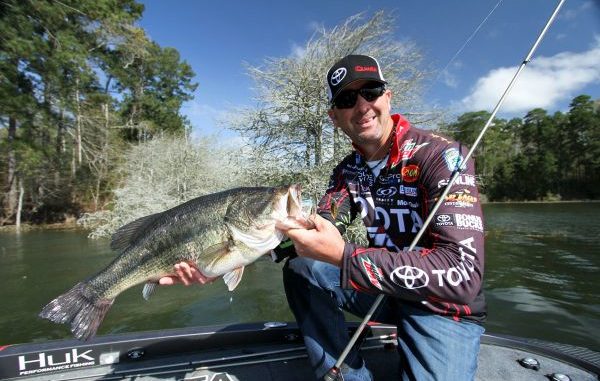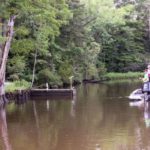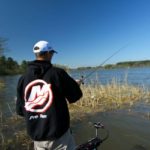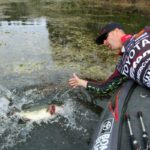
Looking for some winter pre-spawn bass? Just locate some key travel routes and use these pro tips to pick up bites, even when fish are lethargic.
Bass go where bass want to go, but there’s always a logical reason for why they chose their courses. Seasonality drives major relocation, with water temperature and bait positioning being the major influences.
However, the particular travel lanes fish utilize are most often defined by channels, ditches, drains and other contour features.
Whether it’s early pre-spawners tiptoeing out of their winter depths or those contemplating some serious advancement, bass learn the safest and most-convenient routes from one season to the next.
And anglers who learn these travel lanes will fare better when seeking fish during those transitional periods.
We asked a handful of bass pros for their insights on moving with the fish, and they provided some helpful thoughts about how to stay on top of seasonal progression.
Greg Vinson
“One of the key things you look for in the pre-spawn is the spawn itself,” Bassmaster Elite Series pro Greg Vinson said. “You’re looking for spawning areas where you think the fish will be headed, and that’s really your guideline.
“Where do you think the fish were during the winter, during the colder times of the year? And then where are they headed to spawn? You’re going to find them somewhere in between. They’re going to have a route they follow to the pre-spawn staging areas.”
Vinson said he’s learned to look at this progression as if it were a ladder. The classic scenario finds points leading into a spawning area.
“Each point can be like steps on a ladder that they’ll follow,” Vinson said. “We use the term ‘staging,’ and as conditions get nicer and conducive to spawning they move farther toward the spawning areas. But if the weather gets cold and nasty, they might back up a step or two.
“That’s how I mentally approach it, because it can be difficult to keep up with them that time of year with changing conditions.”
Vinson knows he might tempt a pre-spawner any time of the day, but he’s looking for better opportunities later in the day because fish tend to perk up once the water and the cover has had time to gather some solar heat.
“It doesn’t necessarily have to be sunny at the time, but it seems to have helped if you’ve had some sun at some point during the day,” Vinson said. “Probably the best scenario is if most of the day has been sunny and you have a little bit of cloud cover coming in with an approaching front.
“That’s probably the best bite you can get.”
Chris Lane
This past Bassmaster Classic champion said comfort is important.
“Anything that can hold heat is a big key for bass in the wintertime, especially in the southern lakes, because they don’t like to be cold,” Lane said.
But, even during periods of slower metabolism, meals remain an agenda item for largemouth bass. Lethargy is not dormancy, and largemouth bass are heavily guided by their appetites.
“Baitfish is another big thing because the fish have to eat,” Lane said. “They’ll hang on points and drops where the thermocline is in the water, but if the baitfish move, the bass will move, as well.
“So, if the baitfish push shallow, then the bass are going to push shallow. They get up under, say, hyacinth mats to try and keep warm.”
Lane said a lake’s baitfish offer a key indication of where bass will be moving and how fast they’ll want to get there.
“Warming water is what gets things fired up,” Lane said. “The baitfish are just as slow as the bass are in the winter time, so it’s kind of a process of how the whole lake evolves. The little fish start moving around a little more, the big fish start moving around a little more, and then the fishermen start getting on the water more.”
When searching for bass as they move along their late-winter travel routes, one of Lane’s top baits is the Luck E Strike Live Motion Drop Dead Craw — the bait he used to win last year’s Elite Series season opener on the Sabine River.
“That time of year, the fish aren’t into full-blown aggression mode,” Lane said. “You want something that’s a little subtle; you want something that you can be versatile with — either flipping a mat or just flipping the edge of the bank.”
Gerald Swindle
Having spent plenty of time fishing Southern transitional seasons, this Elite Series pro has a good handle on the common elements bass seek.
With less-pronounced channels and ditches than he’d expect to find on a TVA lake such as Guntersville, Swindle knows the travel lanes of most Louisiana and Mississippi waters can be deceptively subtle.
For local bass, though, they’re the conduits to and from seasonal needs. So those are the areas Swindle focuses his attention.
“It could just be a small depression where the bottom of a pocket may swag 2 or 3 feet, but it’s a nice little roll,” Swindle said. “It might look insignificant, but to a fish, with that kind of topo lines, that is a definite travel lane.”
Noting that baitfish will typically winter in the same areas suspended above the bass, Swindle calls these cold season depressions “Mother Nature’s perfect tornado shelter for the fish” because they can find some cover when things get rough.
“If the weather gets really bad, they can hunker down in the bottom of it,” he said. “That’s their lane — they don’t just randomly get out in 6 feet on a mud pocket and just sit — they’re going to be in some kind of depression.”
Down in the Delta region, particularly in the Atchafalaya Basin, Swindle said bait and bass show an even more-distinct connection to the lowest areas of dredged canals.
In any such winter travel lanes, Swindle’s favorite technique is yo-yoing a lipless crankbait.
Armed with a 7-foot medium-heavy rod and a 6.3:1 reel packing 10-pound fluorocarbon, he’ll make a long cast and let the bait drop to the bottom. Then he’ll slowly work it up and down like a jig.
“The bite’s always going to come on the fall,” he said. “What you’re doing is taking a reaction bait and using it in an area where fish are not typically willing to react.
“Just pay attention as the bait falls; you’re going to see your line jump just like a jig.”
Swindle also likes a deep-diving jerk bait this time of year.
He’ll match the depth where he’s marking fish and use the bait’s twitching, slow-falling action to mimic a stunned shad.







